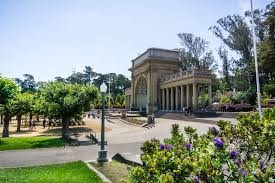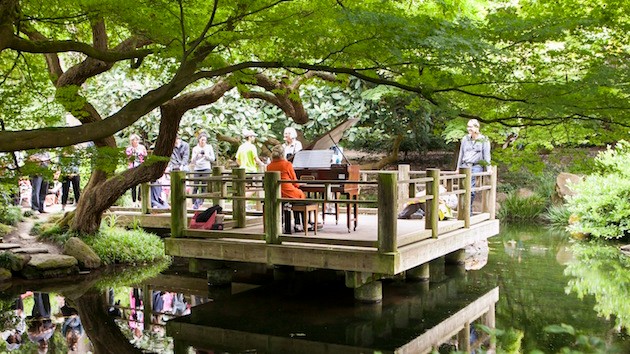San Francisco Botanical Garden
Introduction
Author-Uploaded Audio
Listen to a narration of this entry's description by Jenevieve Hughes.
Text-to-speech Audio
Images
San Francisco Botanical Garden at Strybing Arboretum in Golden Gate Park

"Flower Piano" event on the Moon Viewing Deck at the San Francisco Botanical Garden

Waterfowl Pond, San Francisco Botanical Garden in Golden Gate Park

Backstory and Context
Author-Uploaded Audio
Listen to a narration of this entry's description by Jenevieve Hughes.
Text-to-speech Audio
The origins of this living museum and historic landscape can be traced several decades earlier, to the origins of Golden Gate Park itself, which began to take shape between 1870-1876. During this period, the engineer William Hammond Hall created a detailed site survey and plan for Golden Gate Park, leveling and stabilizing the coastal sand dunes and establishing a nursery for some 60,000 new trees. An overarching vision for Golden Gate Park was further brought to fruition by John McLaren, who served as the Park's first superintendent.
During McLaren's tenure, Helene Strybing's bequest in 1926 provided the necessary funding to create a new Botanical Garden and Arboretum within Golden Gate Park. Throughout the 1930s, the arboretum's first director, Eric Walther, oversaw the selection and importation of numerous varieties of plants and trees from the U.S. and from around the world. The arboretum came to reflect the ecological diversity of many global plant habitats.
In the 1930s, the Works Progress Administration (WPA), a federal program providing jobs for unemployed workers during the Great Depression, supplied the necessary labor for the major construction, landscaping, and initial planting projects at the arboretum. The site officially opened to the public as the Strybing Arboretum in 1940. Upon its grand opening, the Strybing Arboretum featured central axial paths leading to the Zellerbach Perennial Garden, as well as to diverse collections of other outdoor plants and trees.
In 1954, the Strybing Arboretum Society was established to further support the development of the site. In 1959, a new master plan was designed by the landscape architect Robert Tetlow. It included a Great Meadow, a central fountain, and an overall layout of the site, as it still remains today. In the 1960s, a Fragrance Garden was created to provide special aromatic experiences, particularly for people with sight impairments or other disabilities. Plants featured within the Fragrance Garden were selected for their unique scents and interesting textures. The garden beds in the Fragrance Garden were built with stones from a 12th-century Spanish monastery imported to California in 1930 by the publishing magnate, William Randolph Hearst.
In the 1970s, the master plan was expanded to include a new Moon-Viewing Garden, which overlooks a turtle-shaped island. A Horticultural Library was also constructed on site. This collection of books, archival materials, and plant records comprises the largest horticultural library in Northern California. In addition, from the 1980s to early 2000s, the living plant collections at the Strybing Arboretum grew to include a greater number of Mediterranean species and historic varieties of plants that thrive in mild temperate and coastal climates. Other gardens were also created and renovated, including the Southeast Asian Cloud Forest. This unique plant habitat was the first of its kind to be designed within the setting of a botanical garden and living museum.
In 2004, the name of this site was officially changed from Strybing Arboretum to the San Francisco Botanical Garden at Strybing Arboretum. Today, the site is managed jointly in a public-private partnership between the San Francisco Botanical Garden Society at Strybing Arboretum and the San Francisco Recreation & Parks Department. The Botanical Garden offers lectures, classes, tours, and programs for people of all ages. The Youth Education Program, in particular, serves thousands of schoolchildren and includes treasure hunts, guided walks, story-time in the garden, and hands-on experiential learning. The majority of the Botanical Garden's paved pathways are wheelchair accessible and are marked as such by way-finding signage. Wheelchairs are available at entrance gates for no charge on a first come, first served basis. Although there is a daily admission fee, this fee is waived for entrance on Thanksgiving, Christmas Day, and New Year's Day. Admission is always free for members, school groups, and for San Francisco city and county residents with proof of residency.
Sources
"About", San Francisco Botanical Garden. Accessed December 13th 2019. https://www.sfbg.org/about.
"Botanical Garden", Golden Gate Park. Accessed December 13th 2019. https://goldengatepark.com/botanical-garden.html.
Fancher, Lou. "Flower Piano Blooms in the Botanical Garden", San Francisco Classical Voice. Accessed December 13th 2019. https://www.sfcv.org/preview/san-francisco-botanical-garden-society/flower-piano-blooms-in-the-botanical-garden.
"San Francisco Botanical Garden", San Francisco Parks & Recreation. Accessed December 13th 2019. https://sfrecpark.org/destination/golden-gate-park/san-francisco-botanical-garden/.
"Visit", San Francisco Botanical Garden. Accessed December 13th 2019. https://www.sfbg.org/visit.
Natalie Jenks, the San Francisco Classical Voice
San Francisco Recreation and Park Department
